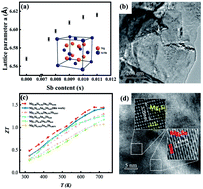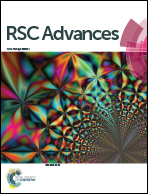Enhanced thermoelectric properties in N-type Mg2Si0.4−xSn0.6Sbx synthesized by alkaline earth metal reduction
Abstract
Mg2Si1−xSnx-based compounds have been recognized as promising thermoelectric materials owing to their high figure-of-merit ZTs, abundance of raw constituent elements and nontoxicity. However, further improvement in the thermoelectric performance in this type of material is still constrained by the high thermal conductivity. In this work, we prepared a series of representative Mg2Si0.4−xSn0.6Sbx (x = 0, 0.0075, 0.008, 0.009, 0.01, 0.011) samples via the alkaline earth metal reduction method through a combination of ball milling and spark plasma sintering (SPS) processes. The samples featured many dislocations at the grain boundaries and plenty of nanoscale-coherent Mg2Si–Mg2Sn spinodal phases; both of which can effectively scatter heat-carrying phonons and have nearly no impact on the carrier transport. Meanwhile, Sb-doping can efficiently optimize the carrier concentration and significantly suppress the bipolar effects. As a result, a maximal ZT of 1.42 at 723 K and engineering (ZT)eng of 0.7 are achieved at the optimal Sb-doping level of x = 0.01. This result indicates that the alkaline earth metal reduction method could be an effective route to engineer phonon transport and improve the thermoelectric performance in Mg2Si1−xSnx-based materials.



 Please wait while we load your content...
Please wait while we load your content...